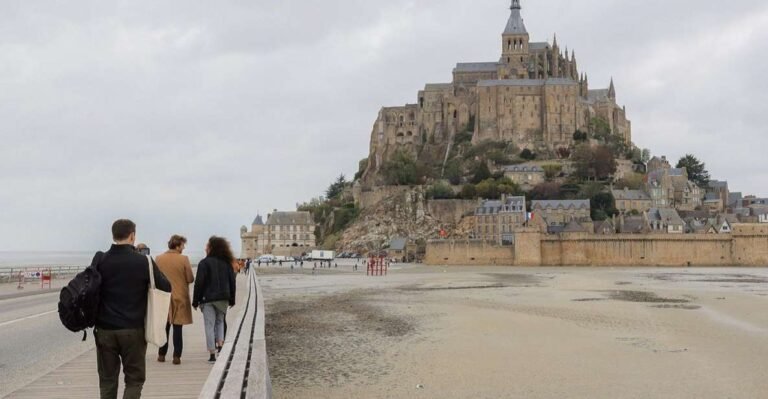Table of Contents
ToggleIntroduction
Nestled off the coast of Normandy, France, Mont Saint-Michel stands as a beacon of medieval architecture and historical significance. This small rocky island, crowned by a stunning abbey, draws millions of visitors each year. But what makes this site so enchanting? Let’s embark on a journey to uncover the marvels of Mont Saint-Michel.
Historical Background
Early Beginnings
The origins of Mont Saint-Michel trace back to the early 8th century. According to legend, the Archangel Michael appeared to St. Aubert, the Bishop of Avranches, instructing him to build a church atop the rocky island. Despite initial resistance, the bishop eventually complied, laying the foundation for what would become one of Europe’s most iconic landmarks.
The Abbey’s Evolution
Over the centuries, Mont Saint-Michel evolved from a humble sanctuary into a sprawling abbey complex. The Benedictine monks, who settled here in the 10th century, played a crucial role in its development. They constructed impressive Gothic and Romanesque structures, transforming the island into a spiritual and architectural marvel.
Architectural Highlights
The Abbey Church
At the heart of Mont Saint-Michel lies the Abbey Church, a masterpiece of medieval architecture.
The Nave
The nave, with its soaring columns and intricate stained glass windows, is a testament to the craftsmanship of the monks. It’s a place where one can feel the weight of history and the serenity of the divine.
The Choir
The choir, designed in the Gothic style, features ribbed vaults and delicate arches. It’s here that the monks would gather for daily prayers, their voices resonating through the hallowed halls.
The Merveille
One of the most striking features of Mont Saint-is the Merveille, or “The Marvel,” a three-story structure that houses various monastic buildings.
The Refectory
The refectory, where the monks dined in silence, is a grand hall lined with narrow windows. The simplicity of the room reflects the ascetic lifestyle of its inhabitants.
The Cloisters
The cloisters, a serene courtyard surrounded by covered walkways, provided a space for meditation and contemplation. The meticulously carved columns and lush greenery create an atmosphere of peace and reflection.
The Mont’s Strategic Importance
Military Significance
Beyond its religious significance, Mont Saint-held strategic military importance. Its location made it a formidable fortress during conflicts, particularly during the Hundred Years’ War. The abbey’s fortifications withstood numerous sieges, earning it a reputation as an impregnable stronghold.
Symbol of National Identity
Mont Saint-also emerged as a symbol of French national identity. During the 19th century, the site was restored and preserved as a historic monument, symbolizing the resilience and cultural heritage of France.
Mont Saint-in Modern Times
Tourism and Pilgrimages
Today, Mont Saint-continues to attract pilgrims and tourists from around the world. Its picturesque views, historical significance, and architectural grandeur make it a must-visit destination. The annual Saint Michael’s Day celebration draws many visitors, offering a glimpse into the island’s rich spiritual heritage.
Preservation Efforts
Preserving Mont Saint-is no small feat. The site faces challenges such as coastal erosion and the impact of millions of visitors. However, ongoing conservation efforts ensure that this medieval marvel remains intact for future generations to admire.
Getting to Mont Saint-Michel
Travel Tips
Planning a trip to Mont Saint-Michel? Here are some tips to make your visit smooth and enjoyable:
- Best Time to Visit: Spring and fall offer pleasant weather and fewer crowds.
- Transportation: Accessible by car, train, or shuttle services from nearby cities like Paris and Rennes.
- What to Bring: Comfortable walking shoes, a camera, and an appreciation for history!
Nearby Attractions
While in the region, don’t miss nearby attractions such as the beautiful town of Saint-Malo, the D-Day landing beaches, and the picturesque countryside of Normandy.
Conclusion
Mont Saint-Michel is more than just a stunning island abbey; it’s a living testament to human ingenuity, faith, and resilience. From its early beginnings as a humble sanctuary to its role as a symbol of national pride, Mont Saint-Michel continues to inspire awe and wonder. Whether you’re a history buff, an architecture enthusiast, or simply seeking a breathtaking destination, Mont Saint-Michel promises an unforgettable experience.
FAQs
1. What is the best time of year to visit Mont Saint-Michel? The best times to visit are during spring (April to June) and fall (September to November) when the weather is pleasant, and the crowds are smaller.
2. How do I get to Mont Saint-Michel from Paris? You can reach Mont Saint-Michel by train from Paris to Pontorson, followed by a shuttle bus to the island. Alternatively, driving or joining a guided tour are convenient options.
3. Are there any guided tours available at Mont Saint-Michel? Yes, there are several guided tour options available, offering insights into the history, architecture, and significance of the site.
4. Is Mont Saint-Michel accessible for people with mobility issues? Due to the steep and uneven terrain, access can be challenging for those with mobility issues. However, some areas are accessible, and assistance may be available upon request.
5. What are some nearby attractions to visit after Mont Saint-? Nearby attractions include the historic town of Saint-Malo, the D-Day landing beaches, and the charming villages and countryside of Normandy.

